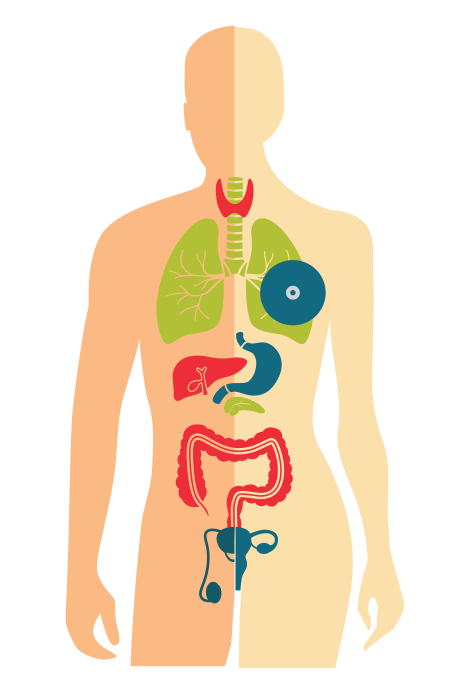Biomarkers are molecules measurable in tissue or blood that are a sign of normal or abnormal processes in the body [1].
In precision oncology research, biomarkers may in the future be diagnostic if they will indicate the presence of disease, prognostic if they will be associated with clinical outcome regardless of treatment received, or predictive if they will predict the benefit or lack of benefit of a treatment [2].
Cancer research is increasingly focused on precision oncology approaches that rely on the detection of biomarkers. Deeper knowledge of molecular pathways, their interactions, and fundamental understanding of cancer biology may elucidate cancer development and tumor progression.
Next-generation sequencing (NGS) enables simultaneous analysis of multiple biomarkers from a single sample.
Oncomine Solutions provide highly automated end-to-end workflows which enable oncology biomarkers detection in a broad spectrum of laboratories.
Download our Biomarker Guides below to learn all you need to know in 2 minutes!

HRD is a phenotype characterized by the inability of a cell to effectively repair double-stranded DNA breaks using the homologous recombination repair (HRR pathway), and plays fundamental role in development of breast, ovarian, prostate and other cancers.
There are two principal approaches for identifying the homologous recombination status of tumors [3]:
Featured Oncomine Solution for HRD assessment: Oncomine Comprehensive Plus Assay identifies both the causes as well as the consequences in one end to end workflow including informatics and with unmatched low hands-on time (HOT).
HER2 alterations have been extensively studied in solid tumors such as breast cancer.
HER2 dysregulation can occur through multiple mechanisms including gene amplifications, activating mutations, and protein overexpression, and these three types of HER2 alterations have been identified in non-small cell lung cancer (NSCLC) with varying prevalence and functional implications.
Whilst other technologies such as FISH, IHC or PCR have been used in past extensively for HER2 testing, NGS can detect both HER2 mutations and HER2 amplifications, with the advantage of simultaneous detecting variants across numerous genes relevant in NSCLC.
Featured Oncomine Solution for Her2 biomarkers detection: Oncomine Precision Assay on Genexus System
Less common mutations in EGFR, such as exon 20 insertions are one of the latest new biomarkers in precision oncology research, and are heterogenous with many variants identified to date [4,5]
While PCR-based assays are widely available and sensitive, their ability to detect EGFR exon 20 insertions are limited to few unique variants.
Given the dozens of known EGFR exon 20 insertions and commercially available PCR tests that can only detect up to 5 distinct insertions, molecular profiling with NGS enables a complete view of common and uncommon EGFR mutations within the context of other relevant genes in NSCLC.
Featured Oncomine Solutions for EGFR testing: Oncomine Precision Assay on Genexus System
![]()
Mutations in IDH1/2 (isocitrate dehydrogenase) lead to neomorphic activity that generate 2-hydroxyglutarate, an oncometabolite that contributes to tumorigenesis.
Genomic studies have revealed the prevalence of IDH1/2 mutations across tumor types including: hematologic malignancies (e.g., acute myeloid leukemia) and solid tumors (e.g., gliomas, chondrosarcomas, and cholangiocarcinoma).
Due to its comprehensive nature, NGS-based analyses are effective for revealing the molecular and genomic features of IDH1/2 mutations.
The PIK3 pathway is one of the most frequently altered pathways in human cancers, and especially prevalent in breast cancer. Somatic mutations in the PIK3CA gene have been shown to be oncogenic, representing a role in the initiation and progression of this tumor type.
While PIK3CA mutations can be identified by reverse transcription polymerase chain reaction (RT-PCR) or Sanger sequencing, NGS approaches for PIK3CA molecular analysis provides more coverage of exonic regions and is suitable for challenging samples such as archival formalin-fixed paraffin-embedded (FFPE) commonly utilized in cancer research.
Featured Oncomine Solution for PIK3CA testing: Oncomine Precision Assay on Genexus System
On-Demand Webinar
Webinar Learning Objectives:
For Research Use Only. Not for use in diagnostic procedures.
References
1. National Cancer Institute. Definition of biomarker. https://www.cancer.gov/publications/dictionaries/cancer-terms/def/biomarker (Accessed May 4, 2023)
2. FDA-NIH Biomarker Working Group. BEST (Biomarkers, EndpointS, and other Tools) Resource. https://www.ncbi.nlm.nih.gov/books/NBK338448/ (Accessed May 4, 2023)
3. Stewart MD, et al. (2022) Homologous recombination deficiency: concepts, definitions, and assays. The Oncologist 27.3: 167-174.
4. Oxnard GR, et al. (2013) Natural history and molecular characteristics of lung cancers harboring EGFR exon 20 insertions. Journal of Thoracic Oncology 8.2 179-184.
5. Vyse S, and Huang P. (2019) Targeting EGFR exon 20 insertion mutations in non-small cell lung cancer. Signal transduction and targeted therapy 4.1: 5.
47855 - Date: September 2023
We've detected your location to be Japan.
Sorry, you cannot access this website. The content on www.oncomine.com is only intended for healthcare professionals. Formore information on our research solutions, please visit ThermoFisher.com
このウェブサイトは、日本国内の医療関係者の方への情報提供を目的としており、一般の方に対する情報提供を目的としたものではないことをご了承ください。研究用製品の情報はThermoFisher.comよりご覧ください。